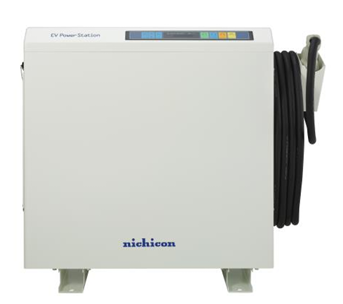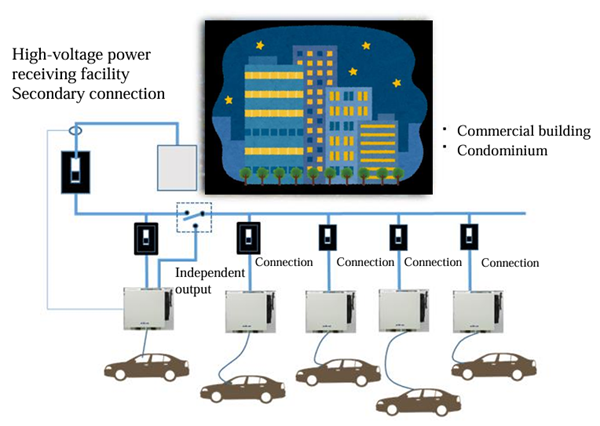Latest Trends in Power Supply Technologies That Help Realize Smart Communities VPP-Related Initiatives That Leverage V2X (V2H, V2G, V2B, and V2F)
Author: Nichicon
1/10/2020
Introduction
The concept of smart communities entails the development of prosperous, sustainable societies that leverage the Internet of Things (IoT) to achieve energy security, environmental sustainability, economy efficiency, and safety (collectively referred to as “3E+S”). Issues that need to be urgently addressed in this context are maximizing the use of renewable energy and building resilient societies that can withstand natural disasters, which have increased in number in recent years. To address these issues, the Ministry of Economy, Trade and Industry (METI) has launched the Energy Resource Aggregation Business Study Group, and is leading a nationwide effort to achieve virtual power plants (VPPs; Figure 1). VPPs aim to establish an appropriate and secure power supply/demand environment by integrating a range of energy-related devices into a network. Two areas that have garnered special attention in this regard are (1) the large power storage capacity of electric vehicles (EVs), and (2) vehicle-to-everything (V2X) systems (in which vehicles transfer power to everything around them, and vice versa). The battery capacity of EVs has risen to an exceptionally high 60-80 kWh in recent years, several times or several tens of times higher than ordinary home energy storage systems, and various ways to utilize this capacity are currently being tested around the world. In Japan, the transition to EVs is finally starting to gain traction, but EV adoption has historically been slow and lagged other countries. This is an important issue that needs to be addressed along with an acceleration in the usage of renewable energy. At the same time, while concerns have been raised over the potential degradation of EVs as vehicles due to frequent charging/discharging, a research report published in the UK (*1) suggests that a certain degree of repeated charging/discharging of lithium-ion batteries by utilizing vehicle-to-grid (V2G) systems improves battery life (by roughly 6%) as opposed to maintaining such batteries fully charged or undercharged. In addition, NICHICON believes that further development of all-solid-state batteries and other initiatives will continue to raise expectations on EVs going forward.
.png)
Source: “ERAB Handbook,” Agency for Natural Resources and Energy
VPP Initiatives That Leverage EVs and V2X
A VPP is a complex concept, but is easier to grasp when thought of in terms of ordinary households, which are its smallest unit. This is because home solar power systems and vehicle-to-home (V2H) systems function as mini power generators within a VPP. Large solar power systems installed on buildings and factories, as well as the aggregate number of EVs, are other components of a VPP. Furthermore, from a community perspective, there is a high likelihood that condominiums and other housing complexes will widely adopt shared use of solar power systems and EVs, including as part of business continuity plans (BCP). Home energy storage systems and EVs have become the main supply targets of solar power generation following the end of the feed-in-tariff (FIT) program, but they also function as the largest source of VPP-supplied balancing power. The greatest challenges facing grid connections that rely on growing renewable energy supply are the inconsistent availability of such energy and the sharp imbalances in power supply/demand throughout the day (commonly referred to as the “duck curve”), which affect regional power grids and cannot be absorbed by thermal power plants due to their slow response to sharp fluctuations in power demand. Some proposals have suggested that power utilities should establish large-capacity power storage facilities as a solution, but this would require a major investment that would ultimately be passed on to consumers. This explains the expectations on EVs (which boast large storage capacity) and V2H systems as infrastructure that can help balance power supply/demand. Meanwhile, from the standpoint of securing independence from power grids, EVs and V2H systems show major promise in promoting off-grid power usage, and such applications are currently being tested alongside BCP. To illustrate how EVs can help balance power supply/demand in power grids, let us take the island of Kyushu as an example. Assuming 5% of the vehicles in Kyushu transition to EVs, the corresponding power capacity would be equivalent to a nuclear power station with two reactors (roughly 2.5 million kW). This would go a long way toward resolving, at least in quantitative terms, the existing sharp imbalances in power supply/demand. While the adoption of EVs has lagged among ordinary households, various related initiatives have been launched in the industrial sector, including promotional initiatives such as EV100 (*2), and vehicle-to building (V2B) and vehicle-to-factory (V2F) systems are being considered as a means to reduce power demand and contribute to BCP. Tests in the UK have already demonstrated that such systems lower power demand, and this is expected to accelerate their adoption in the industrial sector. NICHICON’s newly developed grid-connection-type vehicle-to home system (V2H; Picture 1) is highly responsive to sharp power fluctuations, and is being tested as a source of emergency power using multiple interconnected devices. It also shows promise as a large-capacity backup power source for autonomous driving (Figure 2), and as backbone infrastructure to balance frequency fluctuations under normal grid connections (V2G). Many VPP studies focus on an economic model in which return on investment derives solely from energy trading (electricity charges) and such trading markets are currently being developed. However, comprehensive service businesses that include new services are also being investigated. NICHICON believes a wide range of businesses and accompanying services will continue to be developed, including initiatives to reduce commuting expenses through workplace charging, EV sharing services, and reward point systems based on environmental contributions (discharging of renewable energy power to large facilities).
.png)

Future Challenges in Realizing VPPs
The realization of VPPs comes with a number of challenges, one of which is the technology to manage renewable energy transfers in power transactions among individuals and between individuals and companies in the future. Technologies expected to be rapidly commercialized in this area are renewable energy power certification and trading management technologies that are based on blockchain. A second challenge is how the abovementioned power will be measured. Smart meters for energy trading are currently being installed at all homes, but it remains to be seen whether it is possible to certify power-related data stored inside devices such as solar power systems (solar cells), storage batteries, and EVs as official measurement data. A need to install certified measuring instruments for each such device or system would undermine economic viability. In addition to an amendment of the Measurement Act, measurement certification systems for each type of equipment need to be rapidly reviewed. Finally, another critical component will be the establishment of AI-powered advanced prediction technologies capable of predicting fluctuations in renewable energy, which is unstable due to its reliance on natural forces.
In Conclusion
While the world awaits the rapid realization of VPPs, measures to counter global warming can no longer be put on hold. NICHICON believes the public and private sectors need to come together to actively promote and accelerate adoption of renewable energy devices that can be deployed immediately, V2H systems (EVs) with high capacity to balance power needs as systems that supply balancing power, as well as home energy systems.
*1: “Energy report 2017,” The University of Warwick
*2: A global initiative that aims to promote corporate usage of EVs and environmental preservation.